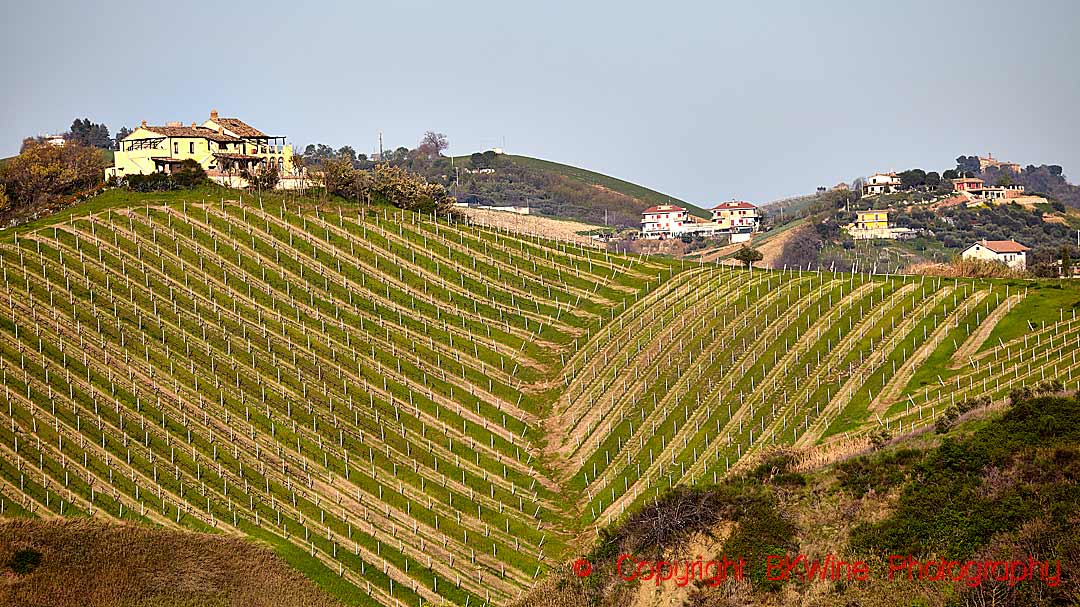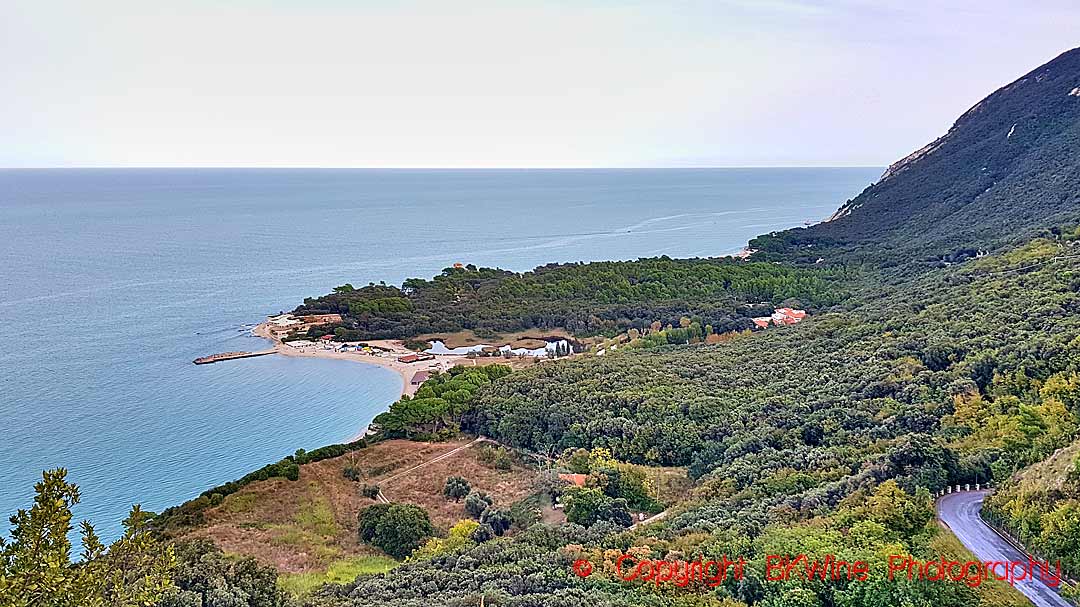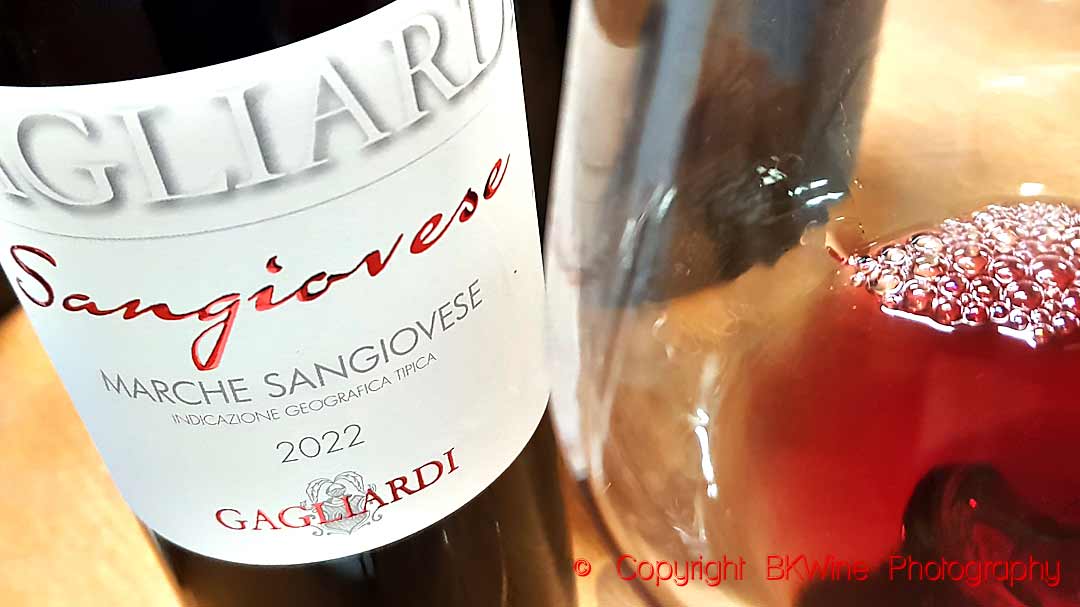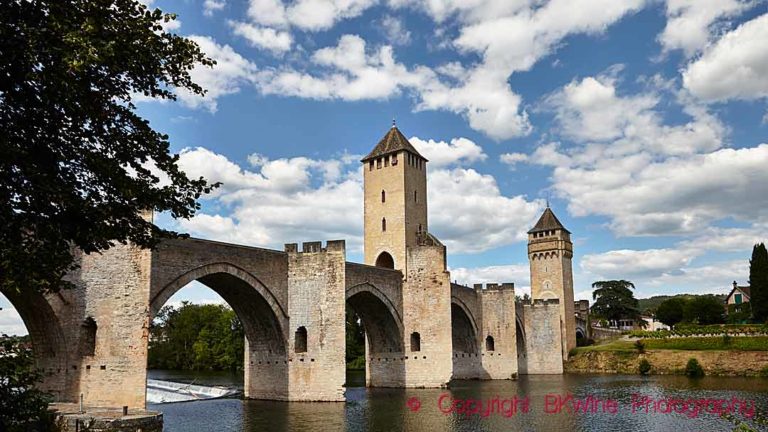Le Marche on the Italian Adriatic coast does not have Ponte Vecchio, the Verona Arena or the Forum. But it does have spectacular Italian landscapes, beautiful beaches and, above all, fantastic food and wine. It has a great variety of wines, some of which are quite unique, and some very specific local gastronomic specialities. Let’s take a closer look what Le Marche has to offer. But not to forget, it also has some other spectacular tourist sites to visit.
Before diving into the wine, and there’s plenty to say about those, let’s take a quick look at some of the more touristic attractions in this Italian region. If you want to go directly to the wine, just skip a few paragraphs.
This is a longer version of an article published on Forbes.com.
Le Marche is sometimes referred to in English as The Marches, but I’ll stick to the Italian version. It is one of the central regions of Italy, on the Adriatic Coast, facing Croatia. It lies south of Emilia-Romagna, east of Tuscany and Umbria, and north of Abruzzo. The biggest city and capital is Ancona, a seaport city with around 100,000 inhabitants.
The Frasassi Caves is an underground grotto system with some breathtaking rock formations. I am not a regular cave visitor – not even an enthusiast for it. In fact, I think this is the first time I visit this kind of grotto, except once in my youth when I was (stupidly) convinced to crawl through some rather too narrow passages. The Frasassi Caves must surely be one of the world’s most amazing underground visits with stalagmites and stalactites that makes you say “wow, is this real?” Yes, it is.
Lace-making might not be your idea of an exciting holiday activity, but if you go to Offida, you’ll see some amazing lacework. They have a long tradition of bobbin lacework and you can still see it done on the streets of this charming old town. They even have a bobbin-lace statue. Not to forget their curious church-on-a-church from the 14th century, there’s a lower church and on top of it an upper church. It is one if Italy’s many charming medieval village. It also has a beautiful theatre that one can visit.
Another quite unique attraction is what is said to be Italy’s only “single vineyard” pasta factory, Mancini Pastificio. Not “vineyard”, of course, but rather “single wheat field”, in other words, pasta made from grains coming from specific wheat fields owned by the factory. It even comes with QR-codes on the packet so you can see exactly which field the pasta comes from.
See more pictures on these things at the end of this article!
And then you have the Castollo di Gradara, and Rocca Roveresca, the Monte San Bartolo nature reserve, Palazzo Ducale di Urbino and many more. All the beautiful villages, of course. One should not forget the many charming beaches, perhaps a welcome retreat after church visits or wine tastings.
Yes, the wine. Let’s get to it!
Italian wine is organised in a sort of hierarchy, not always corresponding to quality, though, with DOCG (denominazione di origine controllata e garantita) at the top and DOC (denominazione di origine controllata) as the following tier. One should not take this as a “quality” indication but rather as something that shows that a wine region has a long history and the producers follow certain rules, which is important in Italy.
Le Marche has five DOCGs:
- Castelli di Jesi Verdicchio Riserva
- Conero
- Offida
- Verdicchio di Matelica Riserva
- Vernaccia di Serrapetrona.
Le Marche has fifteen DOCs:
- Verdicchio dei Castelli di Jesi
- Verdicchio di Matelica
- Rosso Conero
- Rosso Piceno
- Bianchello del Metauro
- Colli Pesaresi
- Pergola
- Lacrima di Morro d’Alba
- Esino
- Colli Maceratesi
- Serrapetrona
- San Ginesio
- I Terreni di Sanseverino
- Terre di Offida
- Falerio
This is how it is standing currently. Things change, even when it comes to wine regulations.
Another very important classification is Indicazione Geografica Tipica or IGT.
But before diving into the various districts, lets take a look at the grapes, which is a rather complicated picture.
Le Marche grape varieties
Le Marche is a great source if you’re looking for unusual grape varieties.
There are two dominant red grape varieties, montepulciano and sangiovese.
Montepulciano usually makes fairly deep-coloured wines. It usually has a medium acidity and not particularly strong tannins. It is quite widely planted in Italy. It is best know from the wines from Abruzzo but is also very common in Le Marche. It has recently been a subject of controversy since the producers in Abruzzo has made some efforts to try and monopolise the name and force other regions – for example Le Marche — to use the little-known synonym cordisco. (Similar to how Italy has monopolised the grape name vermentino (read on Wine-Searcher) and also hijacked the grape name prosecco (read on BKWine Magazine). Why do wine producers do these silly consumer-unfriendly anti-competitive things? It seems to be a particularly popular strategy in Italy.)
The montepulciano grape has nothing to do with the wine region around the town Montepulciano in Tuscany called Vino Nobile di Montepulciano (there, they use sangiovese).
Sangiovese is often slightly lighter in colour and body with a refreshing cherry acidity although there are many different styles, including concentrated and barrel-aged versions. It is often thought of as being a Tuscan grape but is, in fact, planted all over Italy. It is Italy’s most planted grape. Read our grape profile on sangiovese here.
Both Montepulciano and sangiovese are often used together in blends, sometimes with other grapes too, but sometimes also for single-variety wines.
But there is a wealth of other grape varieties in Le Marche that are fascinating to explore and can make excellent and more unusual wines:
- gallioppo, often quite powerful wines with tannins
- ciliegiolo, can be both light a juicy and more concentrated
- lacrima, quite full-bodied, slightly aromatic
- And many more, including more “international” varieties like pinot noir
The most planted grape in Le Marche is the white verdicchio, a grape that gives light to medium-bodied wines with very fresh acidity, citrus notes and pleasant flowery aromatics. The acidity can be very refreshing.
For whites there are also:
- vernaccia, generally light in style with a good fresh acidity, common also in Tuscany
- malvasia, a slightly confusing grape since the name can refer to several different versions, often, but not always, more or less aromatic
- pecorino, fresh, medium-bodied sometimes slightly nutty wines
- passerina
- trebbiano
- pinot bianco
- pinot grigio
- albanella
- biancame (or bianchello)
- maceratino
- and several more
As you can see, Le Marche is not short of interesting and unusual grape varieties.
DOCs and DOCGs
The main wine regions in Le Marche offers a very wide variety in styles and wines, everything you can wish for.
Bianchello del Metauro DOC
Metauro is a river valley stretching northeast from the Apennines into the Adriatic Sea. Bianchello is a white grape, usually called biancame. It is almost exclusively grown in Le Marche, and most of it is in this valley. The appellation has 244 hectares, so you will be lucky to find one of the wines. It is a close cousin to Colli Macerati.
Colli Maceratesi DOC
The Colli Maceratesi – “the hills around the town of Macerata” – stretches far beyond the neighbourhood of the town. No single wine style dominates; the wines can be red, white, still, sparkling, dry or sweet.
Most of the wines here are white, usually made predominantly from another rare local grape variety, the maceratino. This is sometimes specified as Colli Maceratino Ribona. It can be blended with trebbiano toscano, verdicchio, malvasia toscana and/or chardonnay.
The reds must be made from a majority of sangiovese, also possibly blended with several other grapes: cabernet franc, cabernet sauvignon, ciliegiolo, lacrima, merlot and/or montepulciano. Although the denomination stretches over a vast area, less than 100 hectares of vines are planted.
Here are a few producers, but keep in mind that there are many others and many do several different wines/appellations:
- Podere Sabbioni
- Cossignani
- Colleluce
- Luci di Mezzo
Colli Pesaresi DOC
There is both white and red Colli Pesaresi, made around the town of Pesaro on the coast, midway between Ancona and Rimini. They use a wide range of grapes: biancame, chardonnay, pinot bianco, pinot grigio, sauvignon blanc, trebbiano, verdicchio, welschriesling (riesling italico) for whites and for reds: cabernet franc, cabernet sauvignon, merlot, pinot nero, sangiovese.
Conero DOC
Conero, sometimes called Rosso Conero, is one of the more famous appellations in Le Marche. It is named after Monte Conero, which is rather unimpressive as a mountain, 567 metres high, but it is still an impressive feature of the landscape since it is a charming cliff that drops directly into the sea. It is a beautiful coastal location that undoubtedly contributed to its fame. The quite full-bodied wine is made mainly from the montepulciano grape, not to be confused with the Tuscan town of the same name, possibly with a bit of sangiovese. There are 350 hectares. There’s a riserva version that is DOCG.
Here are a few producers, but keep in mind that there are many others and many do several different wines/appellations:
- Tenutal dell’Ugolino
- Montecappone
- Tomassetti
- Fattoria Nanni
- Tenuta San Marcello
- Colle Onorato
- Accadia
- Castellani
- Lanari
- La Calcinara
- Moroder
- Conti Malacari
Esino DOC
A tiny area making reds from mainly montepulciano and sangiovese and for whites verdicchio.
Falerio DOC
Falerio also goes under the name Falerio dei Colli Ascolani, indicating that it comes from the inland hills around Ascoli. It’s a fresh, dry white wine made from a blend of several grape varieties: trebbiano toscano is usually the majority, with the addition of passerina, pecorino (not to be confused with the cheese) and several other varieties.
A special version of it is made exclusively from pecorino (or at least 85%), the Falerio Pecorino.
I Terreni di Sanseverino DOC
A small red wine appellation with wines ranging from light to full-bodied.
Lacrima di Morro d’Alba DOC
Morro d’Alba is a hilltop fortress town with 1821 inhabitants. The wine appellation around it is also small, no more than 258 hectares. The tears (it. lacrima) they manage to squeeze out of the grapes in this hilly area come from a grape variety that almost only exists here in Le Marche, the lacrima. They also make a sweet version from dried grapes.
Here are a few producers, but keep in mind that there are many others and many do several different wines/appellations:
- Gagliardi
- Saputi
- Coppacchioli Tattini
- Casa Lucciola
Offida DOCG
Offida is perhaps the best-known of the local appellations, or one of them. The town it takes its name from has several exciting and touristic features. It is one of the bigger hillside towns with almost 5000 inhabitants. It has a curious church, Santa Maria della Rocca, built on two levels: an upper church and a lower church. On the triangular town square, there’s a beautiful old theatre. But perhaps its biggest claim to fame (apart from the wine) is that it is the capital of bobbin lace making (or pillow lace), a fantastic craft that you can still see in the streets. There’s even a bobbin lace-making statue.
The wine comes in both white and red versions. The whites are made from either the passerina grape or pecorino and are usually labelled Offida Passerina or Offida Pecorino. The red is made mainly from Montepulciano. It must be aged in barrel (not necessarily new, of course) and can’t be released until two years after the harvest. They also make some sparkling and sweet wines.
Here are a few producers, but keep in mind that there are many others and many do several different wines/appellations:
- Aurora
- Podere San Lazzaro
- Vigneti Vallorani
- Irene Cameli
- Vinoffida, Terra Argillosa
- La Valle del Sole
- La Riserva
- Fiorano
- Villa Grifono
- Colli Ripani
- Villa Piatti
- Cherri d’Acquaviva
- San Giovanni di Sole di Terra
- San Filippo
- Poderi dei Colli
- Moncaro
- Pistillo
Pergola DOC
I’ve mentioned several things that “should not be confused with,” and here’s one more. Pergola DOC is a small wine region in Le Marche, not to be confused with the pergola vine training system. It is an aromatic red wine made from the aleatico grape, which is believed to be related to muscat blanc à petits grains.
Here is one producer, but keep in mind that there are others and many do several different wines/appellations:
- Fattoria Villa Ligi
Piceno DOC
Piceno, or Rosso Piceno (since it is always red), is the biggest of the DOCs in Le Marche. It stretches over a large geographic area along the coast, north and south of Ancona, and up into the Apennine Mountains. Most vineyards are on mountain slopes, sometimes going high up, reaching more than 700 m altitude. There are several different styles, but they are all made from a majority of montepulciano, blended with sangiovese and sometimes some other grapes. The area extends over some 4800 hectares.
Here are a few producers, but keep in mind that there are many others and many do several different wines/appellations:
- De Angelis
- Ciu Ciu
San Ginesio DOC
They make red wines from sangiovese and several other different grape varieties and a curious sparkling red made mainly from vernaccia nera.
Verdicchio dei Castelli di Jesi DOC
Without a doubt, the most famous appellation in Le Marche is Verdicchio dei Castelli di Jesi, perhaps not surprising with a reference to Jesus in the name, “the fortresses of Jesus”. However, the origin of the name is not what one usually thinks. It is instead believed to be a reference to a Greek king who founded the town of Jesi in the eighth century BC. His name was Esio.
But perhaps this appellation’s fame is also due to its being one of the biggest denominations in Le Marche, if not the biggest. The 2762 hectares are planted almost exclusively with the verdicchio grape variety, a white grape giving elegant and refreshing whites with crisp acidity. There’s also a riserva version of it that has DOCG.
Here are a few producers, but keep in mind that there are many others and many do several different wines/appellations:
- Casaleta
- Azienda Fiorini
- Roberto Venturi
- Luigi Giusti
- Socci
- Broccanera
- Mezzanotte
- Vigna degli Estensi
Verdicchio di Matelica DOC
Matelica is a small town with less than 10,000 inhabitants, surrounded by vineyards. The main wine made here is the Verdicchio di Matelica, a sister appellation to Verdicchio di Castelli di Jesi, but just a tenth of the size, less than 300 hectares. It is mainly still white but can also be sparkling and sweet (passito) and has a DOCG declination.
Vernaccia di Serrapetrona DOCG
Vernaccia di Serrapetrona is a curious oddity. It is perhaps the smallest appellation in Le Marche, with some 20 hectares. The wine is made from the vernaccia grape, but not the usual white version. Instead it is the red vernaccia nera that is used to make an aromatic red sparkling wine that can be either dry or sweet. There’s also a “plain” (non-sparkling) DOC Serrapetrona.
Riserva, classico, superiore…
Some of these DOCs and DOCGs sometimes add the words riserva, classico, or superiore to their names. This may—or may not—indicate that they are made in a more ambitious style.
IGT Marche
Arguably, equally important as the DOCs and DOCGs, you have the IGT Marche. The DOCs and DOCGs are sometimes said to be “the top of the quality pyramid”. In reality, those indications Denominazione di Origine Controllata and Denominazione di Origine Controllata e Garantita are more a label that shows that it is a wine district that has a specific tradition and history and that a producer follows the rules set up for each denomination/appellation, as well as being limited to a restrictive geographical area. That does not always translate to quality, which more comes from the dedication and talent of the winemaker.
IGT Marche (indication geografica tipica) is a category with looser rules, giving the winemaker more say in what grape varieties to use, what style to choose for the wine, etc. It is also an appellation that covers a much larger geographic region, essentially the whole of Le Marche.
This means that there is a bigger variation of style within “IGT Marche” compared to the DOCs and DOCGs, but also that it is much easier to find on the market. Of course, it has the added benefit to the consumer of clearly showing that it is a wine from Le Marche, which is often not obvious with the other appellations.
Great variety of wine styles
Thus, Le Marche offers an almost infinite variety of wine styles, almost anything you can think of, red, white, rosé sparkling, but also more unusual versions like the sweet passito wines, ice wine, and what is called “cotto”, a sweet “wine” obtained by concentrating the must (and thus the sugar contents) by heating it, notably from Loro Piceno.
Wine producers in Le Marche
One additional good thing with Le Marche wines are that they are usually comparatively affordable. There is a wealth of wines to explore that range between 10 and 25 euro (11 to 27 USD) locally. There are few big producers so what you can find on your local market will depend a lot on what your local wine importer or wine merchant has found among the smaller ones.
One good place to look for these smaller producers is the association of small family-owned wineries called Vignaioli Independenti (or FIVI with the Italian abbreviation). Several of them have been mentioned above, but there are many other to try too.
Perhaps the greatest challenge with Le Marche is its diversity and fragmentation. There are so many small wine districts and such a wide array of grape varieties and styles that it is sometimes difficult to remember what is what. But with a little bit of effort and a desire to discover, you will find many delicious wines from Le Marche. This “challenge” is also one of the great attractions of this beautiful Italian region.
– – –
Some more pictures
The Frassasi Caves
The photographs don’t do it justice. It is majestic. If I remember correctly, the main hall could contain the Notre Dame. The stalagmites and stalactites are enormous, maybe even tens of meters. (Note the height of the walking path guard rail to the right in one of the pictures.)
Lacemaking in Offida
A traditional craft in the town of Offida, still practiced, sometimes in the street.
Stuffed olives
Stuffed and then deep-fried olives is a very peculiar culinary speciality.
Pastificio Mancini
A pasta manufacturer that makes its pasta from wheat fields it owns and where different types of pasta come from certain carefully specified fields. “Single vineyard” type of pasta.













































